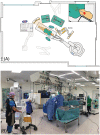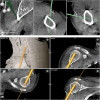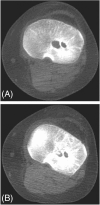Feasibility study of intraoperative cone-beam CT navigation for benign bone tumour surgery
- PMID: 30767360
- PMCID: PMC6593425
- DOI: 10.1002/rcs.1993
Feasibility study of intraoperative cone-beam CT navigation for benign bone tumour surgery
Abstract
Background: Intraoperative cone-beam computed tomography (CBCT) offers the advantage of navigation on the current anatomical situation and the possibility to take a control scan. We assessed the feasibility of using intraoperative CBCT for navigated intralesional curettage.
Methods: Nine benign bone tumour patients were studied. Feasibility was assessed by describing the workflow and indications for navigation, scoring CBCT image quality and registration accuracy, and measuring scan and navigation set-up times. Short-term follow-up was described.
Results: CBCT navigation was successful in all patients. Median tumour visibility, tumour delineation, and vital structure visibility scores were good. Median registration accuracy score was very good. Median scan and verification times were 5 and 3 minutes, respectively. One patient had a tumour recurrence after 6 months.
Conclusions: Intraoperative CBCT navigation is feasible and safe. Indications for use of navigation in clinical practice are closeness to vital structures, complexly shaped tumours or bone, minimally invasive surgery, and repeated surgery.
Keywords: bone; computer assisted surgery; cone-beam CT; image guided surgery; intraoperative imaging; navigation; orthopaedic; tumor.
© 2019 The Authors. The International Journal of Medical Robotics and Computer Assisted Surgery published by John Wiley & Sons Ltd.
Conflict of interest statement
The authors have stated explicitly that there are no conflicts of interest in connection with this article.
Figures




References
-
- Siegel RL, Miller KD, Jemal A. Cancer statistics. CA Cancer J Clin. 2016;66(1):7‐30. - PubMed
-
- Van Der Geest ICM, De Valk MH, De Rooy JWJ, Pruszczynski M, Veth RPH, Schreuder HWB. Oncological and functional results of cryosurgical therapy of enchondromas and chondrosarcomas grade. J Surg Oncol. 2008;98(6):421‐426. - PubMed
-
- Krettek C, Geerling J, Bastian L, et al. Computer aided tumor resection in the pelvis. Injury. 2004;35(1 Suppl):79‐83. - PubMed
-
- Farfalli GL, Albergo JI, Ritacco LE, Ayerza MA, Muscolo DL, Aponte‐Tinao LA. Oncologic and clinical outcomes in pelvic primary bone sarcomas treated with limb salvage surgery. Musculoskelet Surg. 2015;99(3):237‐242. - PubMed
MeSH terms
Grants and funding
LinkOut - more resources
Full Text Sources
Medical

